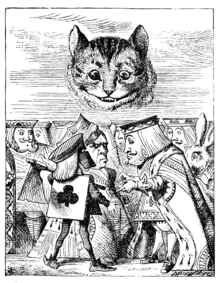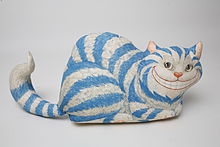Cheshire Cat
The Cheshire [ tʃɛʃə ] Cat ( Cheshire Cat , in German translations Edam-Cat , Cheshire Cat or Cheshire Cat ) is a character from the novel Alice in Wonderland (Alice's Adventures in Wonderland) by Lewis Carroll . It was first drawn by Sir John Tenniel in 1865 for the 1866 edition of the book.
Origin of name
The original English name of the cat refers to the northern English county of Cheshire , where Carroll was born in Daresbury in 1832 and spent his childhood. The phrase "to grin like a Cheshire cat" is an old English phrase. In German translations the name is often rendered with Cheshire Cat . The reason for this is the cat's characteristic grin, and arguably in particular the fact that the cat can disappear while its grin remains visible.
The English phrase "grin like a Cheshire cat" means "big grin". There are several conjectures about the origin of this idiom. One possibility is that this is due to Chester cheese (English Cheshire cheese ), which was formerly shaped in the shape of a cat. The cat "grinned" because the Earls of Cheshire had the privilege of not paying taxes to the Crown.
Another version is that a bad sign painter was responsible for the fact that many of the signs in old Cheshire inns depicted lions that looked like grinning cats.
The most unlikely alternative is with the reign of Richard III. Related: There is said to have been a forester named Caterling. He wanted to eradicate poaching and was responsible for the execution of over a hundred poachers. At the executions he was always “grinning from ear to ear”. His grin was proverbial and his name was later shortened from "Catling" to "Cat".
Alice in Wonderland
The animal appears in the sixth chapter, Pig and Pepper (Pig and Pepper) , on:
- "Please would you tell me," said Alice, a little timidly, for she was not quite sure whether it was good manners for her to speak first, "why your cat grins like that?"
- "It's a Cheshire-Cat," said the Duchess, "and that's why. [...] "
In German translations (here by Antonie Zimmermann for the edition of 1869) this becomes the grinning cat :
- "Will you kindly tell me," Alice asked a little timidly, because she wasn't sure whether it was appropriate for her to speak first, "why your cat is grinning like that?"
- “It's a grinning cat,” said the Duchess, “that's why! [...] "
Further spread
The motif of the Cheshire Cat was picked up by numerous artists and distributed in countless variations, be it as a recreated or redesigned image as in more recent illustrations of the book or as a cartoon character in the Disney production Alice in Wonderland from 1951. In the English film adaptation of the material from 1999 as a feature film under the original title Alice in Wonderland , Whoopi Goldberg's Cheshire Cat is portrayed.
The Cheshire Cat also appears in texts by other authors, for example as a character of the same name in the series of novels by Jasper Fforde , whose work is known for its wealth of literary allusions.
In archeology, the term Cheshire Cat was introduced by Paul Jacobsthal in relation to the first phase of the Celtic art styles. There are motifs on pieces of jewelery, etc., which "at second glance" seem to depict goggle-eyed faces. Jacobsthal compared this effect with the Cheshire Cat, in which at first only the smile can be perceived, but a moment later the rest of the being.
In the book Our Cosmos by Carl Sagan , the cat's grin appears in a demonstration of a fictional planet with variable gravity. The grin is even visible at gravitational forces over that of a black hole .
In a bloodthirsty version, the grinning cat also appears in the games American McGee's Alice and Alice: Madness Returns .
The American pop-punk band blink-182 gave her in 1994, released debut album, also Cheshire Cat . The British indie rock band Milburn named their second single from their debut album Well, Well, Well Cheshire Cat Smile .
The asteroid (6042) Cheshirecat is also named after the Cheshire Cat .
In some pictures of the comic series The Peanuts , Snoopy disappears like the Cheshire Cat except for his smile and in other pictures except for his nose.
A concept of theoretical elementary particle physics that is used in bag models and comes from Holger Bech Nielsen , among others , is called the “Cheshire Cat Principle” after the Lewis Carroll cat. The principle says that the theory resulting from the merging of different descriptions inside and outside a bag with radius R is independent of the exact value of the radius (the radius disappears from the theory like Carroll's cat).
In The Cell as a Habitat by MH Richmond and DC Smith, the Cheshire cat was used as a metaphor to help understand the nature of the mitochondria .
In the Japanese manga Pandora Hearts by Jun Mochizuki, which was also implemented as an anime series, there is also a character by the name of Cheshire Cat.
In the American television series The Simpsons , Milhouse imitates the Cheshire Cat (season six, episode 24).
In the science fiction novel Biokrieg by Paolo Bacigalupi (2009), there is a breed of aggressive wildcats called Cheshire cats that was accidentally crossed with a genetically modified cat.
In his short story The Golden Afternoon (contained in the short story volume “Something ends, something begins”) the Polish author Andrzej Sapkowski tells an alternative version of the events from Alice in Wonderland . Here the Cheshire tomcat appears as a first-person narrator. He has magical powers, can move from wonderland into the human world and saves the life of the real Alice Liddell .
In the song Alice in Wonderland (2018) by the rap singer Disarstar , the Cheshire Cat is repeatedly mentioned in the chorus. It alludes to the populism of the functionary Alice Weidel of the controversial political party AfD .
Trademark rights
The Walt Disney Company has registered extensive trademark rights for the name “Cheshire Cat”.
Web links
Individual evidence
- ^ Robert Hendrickson: The Facts on File Encyclopedia of Word and Phrase Origins , 1997, ISBN 978-0-8160-6966-8
- ^ William White: Notes and Queries: Medium of Enter-Communication for Literary Men, Artists, Antiquaries, Genealogists, Etc. , Volume Second. May-December, 1850, London. George Bell, 186th Fleet Street. 1852, p. 412
- ↑ Artists in their last shirt at augustin.or.at, accessed on May 15, 2017.
- ^ William White: Notes and Queries: Medium of Enter-Communication for Literary Men, Artists, Antiquaries, Genealogists, Etc. , Volume Fifth. January - June, 1852, London. George Bell, 186th Fleet Street. 1852, pp. 402, 403
- ^ Paul Jacobsthal: Early Celtic Art , 1944
- ↑ Disarstar - Alice in Wonderland In: Youtube.com
- ↑ Cheshire cat on the belt buckle In: tagesanzeiger.ch


